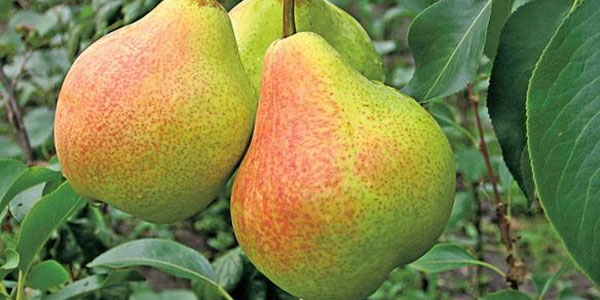SHARE WITH FRIENDS:
Recommended varieties of pears for planting: Williams, Lesnaya Krasavitsa, Lyubimitsa Klappa, Olivier de Serr, Podarok, Starkrimson, etc.
Preparation and planting of seedlings for planting. When preparing seedlings for planting, first of all, taking into account the flow of water in the garden area, the soil is well leveled. Per square meter of area is plowed deep (6–10 cm), adding 200–250 kg of manure, humus, 100–120 g of phosphorus, 150–200 g of potassium and 25–30 g of ammonium nitrogen fertilizer.
Depending on the pear grafts, the planting scheme varies: in strong growing grafts - 6 × 5 m (in irrigated gray soils) and 5 × 5 m (in gravelly-sandy soils), in medium-grained grafts - 5 × 4 m, in low-rise welds - 3 × 2,5 m. Here 3 m - the distance between rows of seedlings, 2,5 m - the distance between seedlings. The period of planting apple seedlings falls in November in autumn, and in early spring in late February-early March.
For planting seedlings are dug pits with a depth and width of 60 × 60 cm. When digging deep, a layer of 20–25 cm of topsoil is placed on one side of the pile, the rest on the other side. 350-400 g of phosphorus, 30-40 g of potassium fertilizer and 8-10 kg of decomposed manure are mixed with the soil and then seedlings are planted. Before planting the seedlings should be immersed in a pre-prepared mulch (fresh cow manure is mixed with the soil in a ratio of 1: 1 to prepare a creamy mass).
Seedlings are placed upright in the middle and buried in the ground. The place of grafting the seedlings should be 4–5 cm above the soil. After planting the seedlings fill each hole with water. Then the soil is compacted and the seedlings sprout well. After the soil settles, new soil is added around the seedlings and filled. Seedlings are watered periodically, depending on soil moisture.
If the area of the plot is 0,03 ha, it is recommended to plant 2-3 bushes of early, middle and late varieties of pear on the east-south side of the area where the sun sets. If the area of the plot is 0,06 ha, it is possible to plant fruit crops in half, fruit trees in the rest, and fruit seedlings in the larger part, leaving space for vegetables at 0,10 ha.
Care. In the spring, the trees are shaped into layers. In this case, 3-4 main branches are left on the first floor of the tree, the rest are cut down. The branches of the second floor are left at a distance of 30-40 cm from the main branches, 25-30 cm from the branches of the first floor. The branches of the third floor are formed in the same way. In shaping, the branches are thinned out in a rhythm, preventing them from shading each other.
Read more: Honey cake
